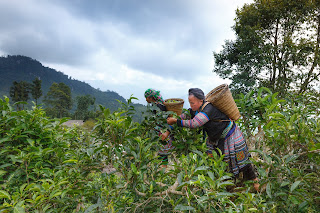History of Green Tea (Green Tea )
What is green tea?
Green tea, also known as unoxidized tea, is made exclusively from the leaves of the Camellia sinensis plant. The leaves are pinched, slightly withered, and then boiled immediately to maintain the green quality and prevent oxidation. Thanks to these methods, green teas have a much higher concentration of chlorophyll, polyphenols and antioxidants than other teas. The conditions under which green tea is grown can be divided into two different types: sun-grown teas and shade-grown teas. The leaves are generally harvested three times a year, and the first colored leaves produce the highest quality leaves. The heating process varies greatly depending on the region and the technique of the tea producer.
Here are some of the common methods used to make green tea
Skillet Roasting - Chinese green teas are usually roasted in a skillet or wok to neutralize natural enzymes and then dried, usually with a light green color like our Dragon Well. Steaming - In general, most Japanese green teas are quickly and thoroughly steamed, resulting in a light green infusion.
HISTORY OF GREEN TEA
Although written records date the cultivation of green tea to the Han Dynasty (206-220), when it was mainly used as a remedy, it was only in the early Tang Dynasty (600-900) that green tea was learned to be consumed for pleasure. At that time, green tea was only distributed in the form of pressed cakes to facilitate transportation.
During the Tang Dynasty, there was a revolutionary book on the art of drinking green tea, which was called "The Tea Classic" or "Cha Jing" by Lu Yu. It is considered one of the most important books of its time, as it was one of the first comprehensive explorations of the entire green tea culture. It was also in this period that the official tea ceremony was born, a ritual accessible only to the wealthy elites, thanks to the tools needed to prepare it. This is why the consumption of green tea has become a status symbol in society.
GREEN TEA TODAY
Green tea has been consumed for longer than any other variety of Camellia sinensis, but the way it is processed has not changed. In many tea-producing countries, green tea is still harvested and processed by hand, and in some cases with the help of very simple and outdated machines, which are passed down from generation to generation. However, the way in which it is consumed has changed radically.
It was not until the end of the 19th century that green tea made its appearance in European and Western cultures. Until the invention of the clipper boat, Western cultures only knew about black tea, which came from freshly picked green tea, usually carried by camel jockeys for months.
These merchants camped out night after night, exposing the tea to the surrounding fires, penetrating the leaves and giving them a charred look and taste. Thanks to the invention of lawn mowers, the teas could be transported in less than half the time, so they arrived in a better state, without treatment. This new means of transport revolutionized the way tea, and green tea in particular, was perceived and experienced forever.
Today, green tea is available on the consumer market in forms ranging from leaf to powder (known as Matcha) and in other consumer products such as baked goods and breath fresheners.
VARIETIES AND VARIATIONS OF GREEN TEA
Since green tea is grown and harvested in many parts of China and Japan, he would easily compile a book trying to explain each variety and variation. Below are some of the most popular varieties of green tea, most of which are available directly from Art of Tea.
Longjing or Dragonwell is fried in a frying pan and has flat sword-shaped leaves. It has a bright jade green color and a fresh, clean, sweet taste and smell.
The powder owes its unique name to the process in which it is produced. The leaves are hand-formed into small balls that look like gunpowder, and with its slightly smoky taste, it is really a fitting name. The main ingredient of Moroccan mint tea, gunpowder helps to complete the flavor by balancing the spiciness of the mint.
Yun Wu or Cloud and Fog is harvested at much higher altitudes and smothered by the clouds. The resulting cup has a light, slightly sweet taste.
Gyokuro, or jade dewdrop tea, is the most precious and sought-after green tea. The selected Tencha leaves are cultivated in the shade for up to 20 days, then harvested and immediately steamed to obtain a higher chlorophyll content. The resulting cup is bright green with a smooth, grassy finish.
Sencha is the most widely used green tea in Japan and is also the basis for many of our green tea blends. Unlike Gyokuro, Sencha leaves are exposed to direct sunlight. Sencha takes its name from the method of decoction in which it is processed, creating a slightly astringent cup of herbs with light herbal tones.
Kukicha, or twigs of tea, consists of twigs, stalks and stems. Usually this tea is made from the remains of the Gyokuro and Sencha harvest. This tea is lightly roasted and slightly more oxidized than most green teas, giving it a nutty flavour with a round, dense aroma.
Matcha is a finely ground powder tea made from Tencha leaves. It is prepared by beating the tea powder with hot water in a ceramic bowl. Matcha is the main form of tea used in traditional Japanese tea ceremonies. The sweet taste of Matcha is due to the amount of amino acids it contains, and the higher the quality, the sweeter and deeper the taste.
Tencha is a shade tea and is mainly harvested for the production of matches. The leaves are laid flat to dry instead of being rolled like most tea leaves and dried completely out of sunlight or indoors. This allows it to retain its darker green colour, which contributes to the production of amino acids.
Genmaicha, commonly known as "popcorn tea", is made from green tea and roasted brown rice. Sometimes referred to as "popcorn tea", the Japanese tradition dictates that farmers add rice to stretch the precious supply of tea to keep the price low. Genmaicha is also said to have evolved since the end of the Second World War. This tea has a light golden hue and a crunchy but roasted aftertaste.
Hojicha is unique because it is not steamed like most Japanese teas, but roasted over charcoal. This process gives the leaves a brown look, similar to black tea. This tea is prepared with a reddish-brown liqueur with a hint of caramel and a slightly roasted aftertaste.
Green tea is best made at a cool water temperature of 180°-185° F, with a brewing time of about 3 minutes. Too hot water can cause the tannins in the leaves to be released, causing the tea to become astringent. High quality green tea can be brewed 2-3 times before the taste fades. It is recommended to use about one teaspoon per 8 ounce cup for best results.
CASE CONTENT
Generally, an 8-ounce cup of green tea releases between 15 and 48 mg of caffeine per serving. This depends on how long the tea has been made. The longer the brewing time, the higher the caffeine content. The caffeine content decreases with each new tea brewing process.











No comments:
Thank you so much for your love and support that help me to serve you batter ,Any suggestion ,Idea and feed back would be Great
Thank very much Stay Safe Stay Healthy From COVID-19